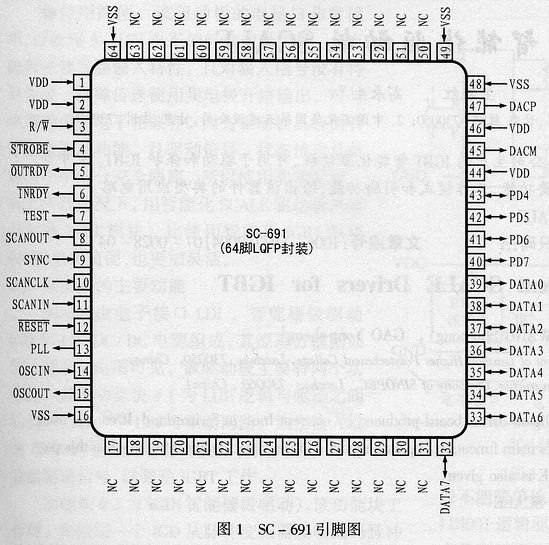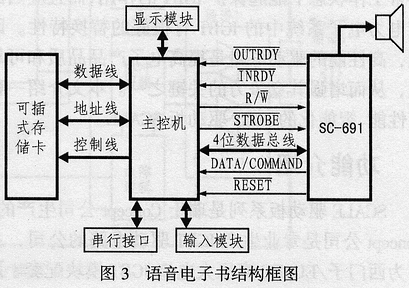Abstract: SC-691 is a high-quality low-data-rate speech and background music synthesis chip produced by SENSORY of the United States. It can support a variety of speech synthesis algorithms, and its data rate can be as low as 1.0bps. SC-691 works in slave mode, so no specific development environment is required. Its biggest feature is that it can play background music while playing voice. It can be used in any product that needs to play voice and music.
1 Overview
SC-691 is a member of the SC-6xx voice synthesis chip family of the US company SENSORY. It works in slave mode, can receive commands and voice compression data from the host, and then convert it into voice output. Because it does not need to master the programming knowledge of SC-6xx, it is the most easy-to-use product in the SC-6xx family.
SC-691 is a standard slave synthesizer that can work with the main processor and can be used in various voice-related products, such as security systems, learning aids, games and toys. Its high quality, low bit rate encryption, easy-to-match interface, digital gain control, low-power sleep mode, and low-voltage operation make it a long time to play voice, short development cycle, and through the slave Ideal device for controlling peripheral devices and other applications. 
SC-691 supports multiple speech synthesis algorithms. Different algorithms use different data storage capacities. When the MX synthesis algorithm is used, the lowest data rate can reach 1.0bps, which means that one second of voice data occupies only one bit of space. Users can weigh the relationship between voice quality and data space to meet their performance and price requirements.
The biggest feature of SC-691 is that its single-channel FM music can be synchronized with CX / MX voice data, which allows SC-691 to play background music while speaking in MX / CC format.
2 Main features 
The SC-691 speech synthesis chip has the following characteristics:
â— Can provide unlimited long-term voice playback through register expansion;
â— The running speed is up to 12.32 MIPS;
â— Support multiple algorithms, the data rate range: up to 1.0kbps ~ -3.5kbps at MX and 8kHz sampling frequency; and 3.0kbps, 3.7kbps, 4 at CX and 8kHz sampling frequency .5kbps, 6.2kbps, 7.7kbps and 11.2bps.
In addition, the device also features ADPC, single-channel FM synthesis, mixed mode of single-channel FM and CX / MX, etc.
â— Use interrupt drive to transmit voice and commands;
â— With 6-level digital gain control;
â— With 4 user-configurable I / O ports;
â— With optional 4-bit or 8-bit data bus; 
◠There are three standby modes to reduce power consumption, which can extend battery life (current in deep sleep mode is less than 10μA);
â— Clock is optional, users can choose low-cost 1% resistor or high-precision 32.368kHz crystal oscillator as system clock according to the situation;
â— Low voltage operation (3V ~ 5.2V), suitable for handheld products;
◠In 4-bit mode, you can stop speaking at any time, and you can send commands while supporting speaking to perform certain tasks, and you can directly drive the 32Ω speaker;
â— Single channel FM music can be played when playing CX / MX voice data;
â— With bare chip and 64-pin LQFP package are available.
3 Pin function and internal structure
SC-691 is available in 36-pin die and 64-pin LQFP packages. Figure 1 is the pin arrangement diagram of its LQFP package. The functional description of each pin is listed in Table 1. Figure 2 is a block diagram of its internal structure.
Table 1 SC-691 pin description
| Lead | Pin name | I / O type | Features |
| 39 ~ 36 | DATA0 ~ DATA3 | input Output | Data bits 0 ~ 3 |
| 35 | DATA4 or DATA / COMMAND | input Output | In 4-bit mode, it is the DATA / COMMAND pin, used to indicate whether the command or data transmitted by the host is data. 8-bit mode is data bit 4 |
| 3432 | DATA5 ~ DATA7 | input Output | Data bits 5 to 7 (in 8-bit mode) |
| 6 | INRDY | Output | The output signal from the slave to the master. Low level indicates that SC-691 is ready to receive data or commands. High level indicates that SC-691 is busy, the host cannot write any data or commands to it |
| 5 | OUTRDY | Output | The output signal sent from the slave to the master. Low level indicates that SC-691 is ready to send commands or data to the host |
| 43 ~ 40 | PD4 ~ PD7 | input Output | Universal I / O bus |
| 3 | R / W | Input | Input signal from the host. Set it high when the host is reading, and set it low when writing |
| 4 | STROBE | Input | Input signal from the host. Used in conjunction with R / W signals in read and write sequences. In the sequence of read / write operations, this signal is pulled high-low-high |
| 15 | OSCOUT | Output | Output of impedance oscillator / crystal oscillator |
| 14 | OSCIN | Input | Input terminal of impedance oscillator / crystal oscillator |
| 13 | PLL | Output | Phase-locked loop filter output |
| 11 | SCANIT | Input | Scan port data input |
| 8 | SCANOUT | Output | Scan port data output |
| 10 | SCANCLK | Input | Scan port clock |
| 9 | SYNC | Input | Scan port synchronization |
| 7 | TEST | Input | Test mode |
| 47 | DACP | Output | Digital and analog output |
| 45 | DACM | Output | Digital analog output |
| 12 | RESET | Input | Reset pin, active low |
| 1, 2, 31, 44, 46 | VDD | Processor power supply, rated voltage is 5V | |
| 16, 48, 49, 64 | VSS | Ground |
4 Application
The power supply voltage (VDD) of the SC-691 type speech and music synthesis chip ranges from 3 to 5.2V, its CPU clock f? CPU? Ranges from 64 to 12320 kHz, and its load resistance R? DAC? Should be greater than 32Ω.
According to the width of the communication data bus, SC-691 has two communication modes: 4-bit mode and 8-bit mode. The bus resources required by the two modes are shown in Table 2.
Table 2 Communication resource allocation table
| Specific bus | SC-691 (4-bit mode) | SC-691 (8-bit mode) |
| Data line bus | 4 | 8 |
| Control line bus | 3 (STROBE, R / W, data / command) | 2 (STROBE, R / W) |
| Status line bus | 2 (INRDY, OUTRDY) | 2 (INRDY, OUTRDY) |
| Universal I / O bus | 4 | 4 |
| Command support (when speaking) | Yes | bundle |
Figure 3 is a system structure diagram of a voice e-book. The plug-in memory card stores the voice data available for SC-691. The content of the e-book can be replaced by replacing the content of the pluggable memory card. In general, MMC cards can be used.
The host computer can communicate with the PC through the serial interface in order to change the content of the e-book. The host computer reads the data in the card and transmits the data to SC-691 to play it out.
Use SC-691 to synthesize and play the received voice data (ie e-book content) signal. Using the display module, the content of the e-book can be displayed in text form.
The input module is used to control e-books, such as switching on / off and reading. In this system, the host computer communicates with SC-691 in 4-bit mode.

Follow WeChat

Download Audiophile APP

Follow the audiophile class
related suggestion